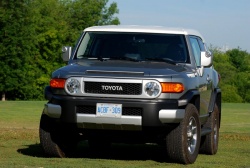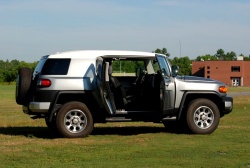 2012 Toyota FJ Cruiser. Click image to enlarge |
|
Test Drive: 2008 Toyota FJ Cruiser
Manufacturer’s web site |
Review and photos by Chris Chase
Photo Gallery:
2012 Toyota FJ Cruiser
The Toyota FJ Cruiser is a modern rendition of the rugged FJ40 Land Cruiser off-road utility vehicle that is iconic among off-road devotees. Its headlight in grille design, up-right windshield with three wipers, and optional roof rack are cues to the original FJ. With a stocky body, extremely wide C pillars and two-door design, the FJ Cruiser is curiously appealing. I’ve heard it described as both rugged (males) and cute (females).
The FJ Cruiser was a popular addition to the Toyota lineup with 9,820 Canadians giving rugged and/or cute a high priority in its first model year (2006 and 2007 combined). But such perceptions have limitations as sales dropped to 2,630 in 2008, 899 in 2009, 797 in 2010—you get the picture, a slow descent into quicksand. The US experience was quite similar, just multiply by 10.
Apparently consumers don’t need auto writers to help them make intelligent decisions.
 2012 Toyota FJ Cruiser. Click image to enlarge |
This is not a knock on the FJ Cruiser, which does what it is designed for extremely well, but evidence of the left to right brain switch that many consumers probably experience once they realize that their dream vehicle doesn’t really meet their needs. Once they see how well equipped a RAV4 can be at $35,045 (Limited 4WD), it can be difficult to still lust after the FJ at a starting price of $32,725 ($38,745 as tested). Add to this four real doors, better rear seat leg room, much better visibility, way better fuel economy (AND at time of writing a $3,000 incentive for cash buyers on the RAV4, but only $1,500 on the FJ), and one can see that the FJ Cruiser might have a positive impact on RAV4 sales.
Based on the Toyota Tacoma pickup truck, the FJ Cruiser has a full frame, meaning despite the looks, it is a truck too. The sole engine choice is a 4.0L V6 that makes 260 horsepower and 271 lb-ft of torque, while a choice of a six-speed manual or five-speed automatic transmission is available. All models feature a two-speed transfer case, traction control, vehicle stability control, and fuel tank and transfer case protector plates.
The six-speed manual transmission includes full-time four-wheel drive, which splits the torque 40/60 under normal driving conditions but can redistribute as necessary, and the rear differential lock can be manually engaged for 50/50 distribution. Our test vehicle was equipped with the optional five-speed automatic, which includes part-time 4WD with shift-on-the-fly capability.








